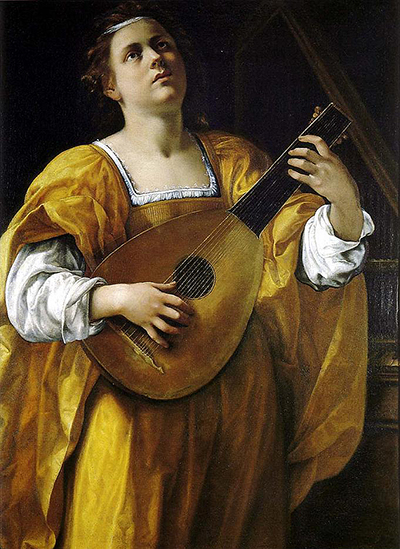Saint Cecilia is an early painting by the Italian Baroque painter Artemisia Gentileschi, that depicts the Saint playing a lute, which is a string instrument that could be comparable to a guitar.
Art historians think the painting was painted between 1616 to 1620, and it is painted in the traditional Baroque style associated with Artemisia Gentileschi. It is a very famous piece that is widely recognised and printed across the world. Anyone who is familiar with the style of Caravaggio will recognise this painting, the style at least if not the painting itself.
What is the history behind Saint Cecilia by Artemisia Gentileschi?
Due to the time period this piece was painted in, this would have been painted in the artists "Florentine period". After her arranged marriage, Artemisia moved to Florence with her new husband Pierantonio_Stiattesi, where she completed many of her early paintings like Saint Cecilia. It could be argued that this was one of her most successful periods as an artist. During this time she became a court painter, enjoying patronages of Charles the first and the House of Medici. She maintained good relationships during this period with a number of artists around her like, Cristofano Allori, and created a significant network around her of her peers.
What is in the painting and what style is it?
The painting is an oil on canvas piece, painted in the Baroque style, very similar to the dramatic works of Caravaggio. Artemisia was one of the only women painters at the time who worked in the style of Caravaggio which is what set her apart from the rest of her female contemporaries. The painting shows Saint Cecilia playing the lute, which was a very popular instrument at the time. Unusually, there is an organ in the background. This confirms the subject as Saint Cecilia herself and adding inanimate objects into the background was a common method to highlight the actual subject of the painting.
Where is the painting now?
The painting is kept in the Galleria Spada in Rome. It has been part of the Spada collection since the seventeenth century. The Galleria Spada is one of the more little-known galleries in Rome, but houses artwork such as Michelangelo Cerquozzi: Revolt of Masaniello, Parmigianino (school): Three heads and Pieter van Laer (il Bamboccio): Storm; Nocturne.




